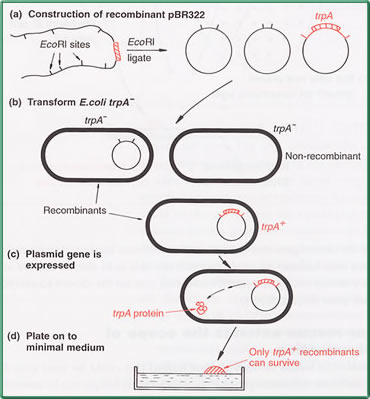Extending the Scope of Direct Selection

Direct Selection would be very limited indeed if it could be
used only for cloning antibiotic resistance genes. Fortunately
the technique can be extended by making use of mutant
straints of E. coli as the hosts for transformation.
As an example, consider an experiment to clone the
gene trpA from Ecoli. This gene codes for the enzyme
tryptophan synthase, which is involving in biosynthesis
of the essential amino acid tryptophan.
A mutant strain
of E.coli that has a non-functional trpA gene is called
trpA-, and is able to survive only if tryptophan is
added to the growth medium. E.coli trpA- is therefore
another example of an auxotroph(as shown in image).

This
E. coli mutant can be used to clone the correct version
of the trpA gene, Total DNA is first purified from a
normal (wild-type) strain of the bacterium.
Digestion
with a restriction endonuclease, followed by ligation
into a vector, produces numerous recombinant DNA molecules,
one of which may, with luck, carry an intact copy of
the trpA gene (a). This is of course the functional
gene as it has been obtained from the wild-type strain.
The ligation mixture is now used to transform the auxotrophic
E.coli trpA- cells. The vast majority of the resulting
transformation will be auxotrophic, but a few now have
the plasmid-borne copy of the correct trpA gene. These
recombinants are non-auxotrophic - they no longer require
tryptophan as the cloned gene is able to direct production
of tryptophan synthase (c).
Direct Selection is therefore
performed by plating transformants onto minimal medium,
which lacks any added supplements, and in particular
has no tryptophan (d). Auxotrophs cannot grow on minimal
medium, so the only colonies to appear are recombinants
that contain the clones trpA gene.
Next: The
Scope and Limitation of Marker Rescue
|

